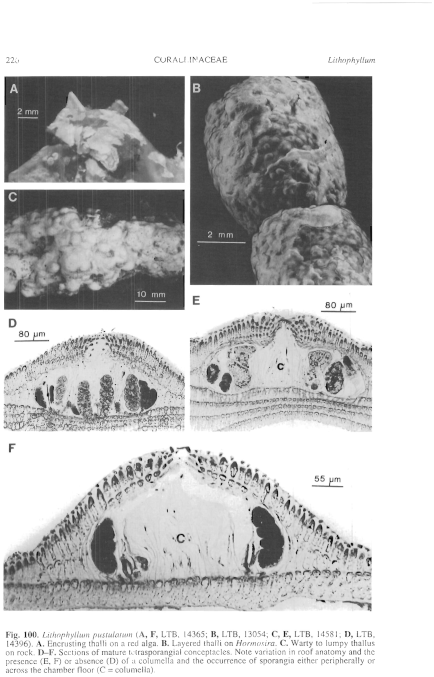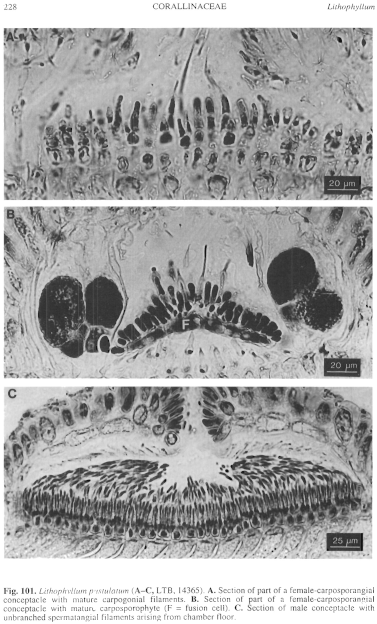|
|
|
|
|
|||||||||||
|
Electronic Flora of South Australia Species Fact Sheet
Phylum Rhodophyta – Class Florideophyceae – Order Corallinales – Family Corallinaceae – Subfamily Lithophylloideae
Selected citations: Barry & Woelkerling 1995: 138. Campbell & Woelkerling 1990: 115, figs 1,4. Millar & Kraft 1993: 14. Suneson 1943: 39, figs 22, 23, pl. 6 figs 26, 27. Woelkerling & Campbell 1992: 78, figs 50–60.
Synonyms
Melobesia pustulata Lamouroux 1816: 315.
Dermatolithon pustulatum (Lamouroux) Foslie 1898b: 11.
Epilithon pustulatum (Lamouroux) Lemoine 1921: 10.
Tenarea pustulata (Lamouroux) Adey 1965: 88 (invalid).
Titanoderma pustulata (Lamouroux) Nägeli 1858: 532. Chamberlain 1991: 26, figs 2, 4, 7–15, 19–48, 52a-i, 53–207. Chamberlain & Irvine 1994b: 96, figs 39–49. Woelkerling et al. 1985: 329, figs 29–39.
Additional references involving these and other binomials, previous southern Australian records, and heterotypic synonyms are given by Woelkerling & Campbell 1992.
Thallus normally pinkish, encrusting to layered or rarely warty or lumpy, mostly 1–100 mm across and 0.05–2.5 mm thick or tall, epigenous and partially or completely affixed by cell adhesion; lamellate branches applanate and inconspicuous. Structure pseudoparenchymatous with dorsiventral organisation throughout; construction dimerous, consisting of a single ventral layer of branched, laterally cohering, filaments each composed of palisade and/or non-palisade cells 5–25 µm long and (12–) 25–75 (–100) µm high, and additionally of epithallial cells or more commonly of simple or branched, laterally cohering, filaments that arise dorsally and more or less perpendicularly from cells of ventral layer filaments and are each usually composed of cells 5–14 µm in diameter and (5–) 16–55 (–65) µm long; epithallial cells 3–12 µm in diameter and 2–8 µm long, terminating most filaments at the thallus surface, with distal walls rounded or flattened but not flared; cells of adjacent filaments joined by secondary pit-connections; cell-fusions, haustoria, and trichocytes not observed.
Reproduction: Vegetative reproduction unknown. Gametangia, carposporangia, tetrasporangia and bisporangia produced in uniporate conceptacles; gametangia and carposporangia formed on thalli separate to those bearing tetrasporangia and bisporangia.
Gametangial thalli probably dioecious. Carpogonia terminating 2- or 3-celled filaments arising from the conceptacle chamber floor. Mature female-carposporangial conceptacle roofs protruding above surrounding thallus surface, 60–100 µm thick, composed of 6–8 layers of cells above the chamber, conceptacle chambers 220–300 µm in diameter and 85–110 (–177) µm high. Carposporophytes composed of a conspicuous central fusion cell and several-celled gonimoblast filaments bearing terminal carposporangia 30–75 µm in diameter. Spermatangial filaments unbranched, borne across the male conceptacle chamber floor; mature male conceptacle roofs protruding above surrounding thallus surface, 40–65 µm thick, composed of 7–9 layers of cells above the chamber, male conceptacle chambers (53–) 220–450 µm in diameter and 50–90 µm high.
Tetrasporangial/bisporangial conceptacle roofs protruding above surrounding surface, 2–7 cells thick above the chamber, pore canals lined with non- or somewhat protruding cells that do not completely occlude the canal, conceptacle chambers (162–) 390–500 (–556) µm in diameter and 110–180 µm high, floor of mature chambers usually 1–3 (–5) cells below thallus surface; tetrasporangia and bisporangia scattered across the conceptacle chamber floor or peripheral to a central columella, each mature sporangium 35–85 µm in diameter and 95–140 µm long, containing zonately arranged tetraspores or bispores.
Type from an unknown locality in France; lectotype in CN (Herb. Lamouroux, unnumbered); designated by Woelkerling, Chamberlain & Silva (1985, p. 325); depicted in Woelkerling, Chamberlain & Silva (1985, p. 328, fig. 29) and Woelkerling & Campbell (1992, p. 80, fig. 50A).
Selected specimens: Herald Bight, Shark Bay, W. Aust., 1–2 m deep (Harlin, 12.ix.1984; LTB, 16631, 16634, 16639, 16640, 16686). Cape Vlaming, Rottnest I., W. Aust., reef pools (Woelkerling, 8.ii.1978; LTB, 12667). Lucky Bay, Cape Le Grand National Park, W. Aust., 0–3 m deep (Woelkerling, Platt, & Jones, 9.ii.1984; LTB, 14301, 14361, 14365, 14367). Eyre ("Nine Mile Reef"), W. Aust., 2–3 m deep (Woelkerling, Platt, & Jones, 1.ii.1984; LTB, 13953, 13956). Head of Great Australian Bight, S. Aust., drift (Woelkerling, Platt, & Jones, 13.ii.1984; LTB, 14377, 14380). Point Fowler, Fowlers Bay, S. Aust., 2–3 m deep (Woelkerling, Platt, & Jones, 14.ii.1984; LTB, 14464, 14390, 14396, 14398). Point Westall, S. Aust., 2–3 m deep (Platt & Jones, 16.ii.1984; LTB, 14581). Pondalowie Bay, Yorke Pen., S. Aust., upper sublittoral (Woelkerling, 31.xii.1976; LTB, 12473). Vivonne Bay, Kangaroo I., S. Aust., large pool, S side Ellen Point (Womersley, 17.i.1948; AD, A7907 = LTB, 13594). Beachport (Post Office Rock), S. Aust., 0–3 m deep (Campbell & Penrose, 6.xi.1987; LTB, 15843). Warrnambool, Vic., low eulittoral (Pope & Bennett, 16.viii.l948; AD, Al2125 = LTB, 13700). Point Lonsdale, Vic., reef pools (Turner, 6.i.1979; LTB, 11542). Bluestone Bay, Freycinet Pen., Tas., intertidal pools (Platt & Woelkerling, 21.ii.1983; LTB, 13054, 13055). Green Cape, N.S.W., 1–2 m deep (Platt, 31.xii.1982; LTB, 12635).
Distribution: Widespread, but many published records involve misidentifications; see Chamberlain (1991) and Woelkerling & Campbell (1992).
In Australia, Herald Bight, Shark Bay, W. Aust., to Cape Green, N.S.W., and Bluestone Bay, Tasmania. An additional collection (not seen) has been reported from Narrabeen, New South Wales (Millar & Kraft 1993, p. 14).
Taxonomic notes: Lithophyllum pustulatum has been found in Australia on rock, sponges, abalone shells, snails, seagrasses and various red and brown algae in intertidal pools and subtidally to depths of 5 m. Gametangial, carposporangial, tetrasporangial and bisporangial thalli can occur in the same population, but bisporangia and tetrasporangia were not found on the same thallus. In the British Isles, Chamberlain (1991, as Titanoderma) and Chamberlain & Irvine (1994b, as Titanoderma) found only bisporangial thalli. Woelkerling & Campbell (1992, p. 95) and Chamberlain & Irvine (1994b, p. 99) both suggest that the British populations are probably apomictic and that this has led to the occurrence of taxonomically recognisable varieties that appear morphologically stable. In southern Australia, Woelkerling & Campbell (1992) found that populations were highly and continuously variable making it impossible to identify clear-cut varieties.
References:
ADEY, W.H. (1965). The algal tribe Lithophylleae and its included genera. Colo. Sch. Mines Q. 60 (2), 67–102. Note: part of Johnson, J.H. & Adey, W.H. 1965. Studies of Lithophyllum and related algal genera. Color. Sch. Mines Q. 60 (2):1–105
BARRY, G.C. & WOELKERLING, W.J. (1995). Non-geniculate species of Corallinaceae (Corallinales, Rhodophyta) in Shark Bay, Western Australia: biodiversity, salinity tolerances and biogeographic affinities. Botanica Mar. 38, 135–149.
CAMPBELL, S.J. & WOELKERLING, W.J. (1990). Are Titanoderma and Lithophyllum (Corallinaceae, Rhodophyta) distinct genera? Phycologia 29, 114–125.
CHAMBERLAIN, Y.M. & IRVINE, L.M. (1994b). Lithophylloideae Setchell. In Irvine, L. M. & Chamberlain, Y. M. (Eds), Seaweeds of the British Isles. Volume 1 Rhodophyta Part 2B Corallinales, Hildenbrandiales pp. 58–112. (HMSO: London.)
CHAMBERLAIN, Y.M. (1991). Historical and taxonomic studies in the genus Titanoderma (Rhodophyta, Corallinales) in the British Isles. Bull. Br. Mus. Nat. Hist. (Bot.) 21, 1–80.
FOSLIE, M. (1898b). List of species of the lithothamnia. K. norske Vidensk. Selsk. Skr. 1898(3), 1–11.
FOSLIE, M. (1904c). Die Lithothamnien des Adriatischen Meeres and Marokkos. Wiss. Meeresunters., Abt, Helgoland, N. F. 7(1), 1–40, Plates 1–3. Note: issued as an offprint without change in pagination in 1904; journal version was published in 1905.
LAMOUROUX, J.V.F. (1816). Histoire des Polypiers Coralligènes Flexibles. (Poisson: Caen.)
LEMOINE, M.(Mme P.) (1921). Note sur les algues calcaires recueillies par MM. A. et L. Joleaud et catalogue des mélobésiées des côtes françaises de la Méditerranée. Bull. Soc. linn. Provence 3, 5–15,
MILLAR, A.J.K. & KRAFT, G.T. (1993). Catalogue of Marine and Freshwater Red Algae (Rhodophyta) of New South Wales, including Lord Howe Island, South-western Pacific. Aust. Syst. Bot. 6, 1–90.
NÄGELI, C. (1858). Die Stärkekörner. (Friedrich Schulthess: Zurich.) Note: Constitutes Volume 2 of Nägeli, C. & Cramer, C., Pflanzenphysiologische Untersuchungen.
SUNESON, S. (1943). The structure, life-history, and taxonomy of the Swedish Corallinaceae. Lunds Univ. Årsskr., N.F., Avd. 2, 39(9), 1–66, Plates 1–9.
WOELKERLING, W.J. & CAMPBELL, S.J. (1992). An account of southern Australian species of Lithophyllum (Corallinaceae, Rhodophyta). Bull. Br. Mus. Nat. Hist., Bot. Ser. 22, 1–107.
WOELKERLING, W.J., CHAMBERLAIN, Y.M. & SILVA, P.C. (1985). A taxonomic and nomenclatural reassessment of Tenarea, Titanoderma and Dermatolithon (Corallinaceae, Rhodophyta) based on studies of type and other critical specimens. Phycologia 24, 317–337.
The Marine Benthic Flora of Southern Australia Part IIIB complete list of references.
Publication:
Womersley, H.B.S. (28 June, 1996)
The Marine Benthic Flora of Southern Australia
Rhodophyta. Part IIIB. Gracilarialse, Rhodymeniales, Corallinales and Bonnemaisoniales
Reproduced with permission from The Marine Benthic Flora of Southern Australia Part IIIB 1996, by H.B.S. Womersley. Australian Biological Resources Study, Canberra. Copyright Commonwealth of Australia.
Illustrations in Womersley Part IIIA, 1996: FIGS 100, 101.

Figure 100 enlarge
Fig. 100. Lithophyllum pustulatum (A, F, LTB, 14365; B, LTB, 13054; C, E, LTB, 14581; D, LTB, 14396). A. Encrusting thalli on a red alga. B. Layered thalli on Hormosira. C. Warty to lumpy thallus on rock. D–F. Sections of mature tetrasporangial conceptacles. Note variation in roof anatomy and the presence (E, F) or absence (D) of a columella and the occurrence of sporangia either peripherally or across the chamber floor (C = columella).

Figure 101 enlarge
Fig. 101. Lithophyllum pustulatum (A–C, LTB, 14365). A. Section of part of a female-carposporangial conceptacle with mature carpogonial filaments. B. Section of part of a female-carposporangial conceptacle with mature carposporophyte (F = fusion cell). C. Section of male conceptacle with unbranched spermatangial filaments arising from chamber floor.

|
Email Contact: State Herbarium of South Australia |

|